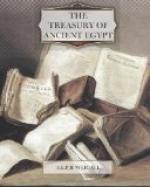This, of course, was a very exceptional discovery. Mr Davis has made other great finds, but to me they have not equalled in dramatic interest the discovery just recorded. Even in this royal valley, however, there is much drudgery to be faced, and for a large part of the season’s work it is the excavator’s business to turn over endless masses of rock chippings, and to dig huge holes which have no interest for the patient digger. Sometimes the mouth of a tomb is bared, and is entered with the profoundest hopes, which are at once dashed by the sudden abrupt ending of the cutting a few yards from the surface. At other times a tomb-chamber is reached and is found to be absolutely empty.
At another part of Thebes the well-known Egyptologist, Professor Schiaparelli, had excavated for a number of years without finding anything of much importance, when suddenly one fine day he struck the mouth of a large tomb which was evidently intact. I was at once informed of the discovery, and proceeded to the spot as quickly as possible. The mouth of the tomb was approached down a flight of steep, rough steps, still half-choked with debris. At the bottom of this the entrance of a passage running into the hillside was blocked by a wall of rough stones. After photographing and removing this, we found ourselves in a long, low tunnel, blocked by a second wall a few yards ahead. Both these walls were intact, and we realised that we were about to see what probably no living man had ever seen before: the absolutely intact remains of a rich Theban of the Imperial Age—i.e., about 1200 or 1300 B.C. When this second wall was taken down we passed into a carefully-cut passage high enough to permit of one standing upright.
At the end of this passage a plain wooden door barred our progress. The wood retained the light colour of fresh deal, and looked for all the world as though it had been set up but yesterday. A heavy wooden lock, such as is used at the present day, held the door fast. A neat bronze handle on the side of the door was connected by a spring to a wooden knob set in the masonry door-post; and this spring was carefully sealed with a small dab of stamped clay. The whole contrivance seemed so modern that Professor Schiaparelli called to his servant for the key, who quite seriously replied, “I don’t know where it is, sir.” He then thumped the door with his hand to see whether it would be likely to give; and, as the echoes reverberated through the tomb, one felt that the mummy, in the darkness beyond, might well think that his resurrection call had come. One almost expected him to rise, like the dead knights of Kildare in the Irish legend, and to ask, “Is it time?” for the three thousand years which his religion had told him was the duration of his life in the tomb was already long past.




